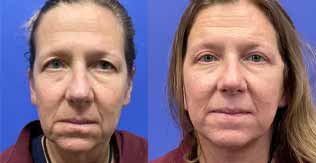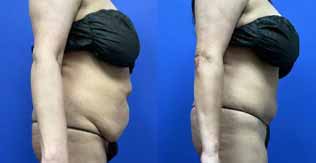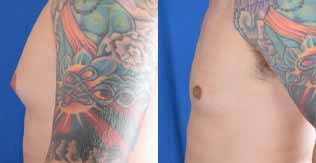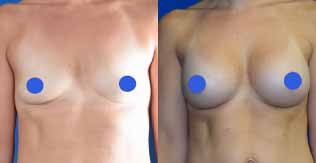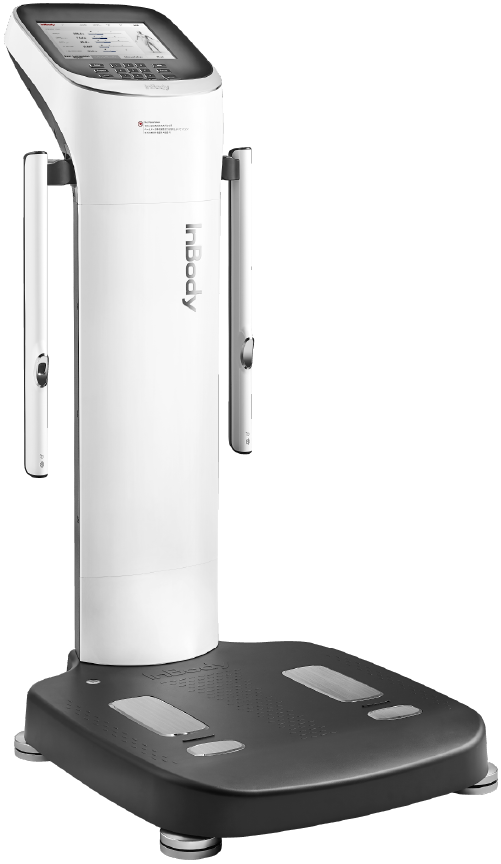InBody 970
Offered at our convenient location in Denver
InBody 970 is a state-of-the-art body scanning technology that measures and assesses multiple aspects of body composition, fluid distribution, and body structure. With a non-invasive InBody 970 scan, patients can receive a more comprehensive, in-depth view of their health, assess their injury risks and areas of weakness, and optimize their fitness goals. In just a few seconds, the analyzer sends a low-level electrical signal throughout the body, producing an extensive one-page report in as little as 45 seconds. Patients can review this assessment with a medical professional to gain more insight into the results. They can also compare and contrast their results throughout the weeks, tracking their progress along the way.
At Millard Plastic Surgery, we believe in giving patients more access and agency when it comes to learning about their health. With the expertise of our reputable, team of plastic surgeons, you can reap the benefits of one of the most highly advanced, FDA-approved body-mapping machines available.
If you are interested in reaching new health and fitness goals with this technology, reach out to our reputable practice in Denver at (303) 792-5665, or reach by filling out our contact form. One of our attentive professionals will gladly schedule an appointment that works best for your schedule.
Contents
How Does the InBody 970 Work?
The InBody 970 is a type of bioelectrical impedance analysis (BIA) machine. This means that as the electrical signal travels throughout the body, the device measures the level of resistance- accurately determining the type of tissues it comes across. For example, signals that travel through denser tissues, such as bone, will move slower with more resistance. The InBody 970 can provide patients and healthcare providers with an internal look at the body without the use of harmful radiation waves from scans such as X-rays. In addition, patients do not feel these pulses, and they can safely undergo as many scans as they would like.
Henry Lukaski, PhD was one of the first pioneers of utilizing BIA technology in adults; in 1985, he researched a method of harnessing electrical impedance to measure patients’ fat and non-fat composition. (1) Since then, machines have not only become more sophisticated, but they have become more user-friendly and personalized. The InBody 970 can store the individual results of up to 10,000 patients, making it a perfect addition to our Denver practice.
Body Composition Analysis
InBody 970 gained FDA approval in 2020, making it one of the latest BIA machines that can provide valuable information regarding a variety of health conditions. Firstly, the device can formulate two types of reports: water composition and body composition.
InBody’s ability to measure fluid retention can help healthcare professionals uncover more serious conditions like kidney disease, heart disease, or sites of injury and inflammation. Besides that, comprehending how fluid moves within your body is essential for quality hydration and electrolyte balance during tough exercises.
Understanding your muscle, fat, and skeletal mass and their relation to each other is critical to getting high-quality results at the gym. For some, certain types of physical exercise can produce more reliable muscle-building or fat-burning results. With properly informed interpretation, an InBody scan can give you the valuable information you need to get ahead with your records at the gym or on the scale:
- Total body water: Measures the total amount of water in your entire body.
- ECW (extracellular water)/ TBW (total body water): The ratio of water outside of your body’s cells- in the extracellular matrix- and the total water overall. This provides details on how much water is being used within your cells and overall water balance.
- ICW (Intracellular water): Only measures the amount of water within cells.
- Extracellular water: Only measures the amount of water outside of cells.
- Body fat percentage: Fat mass compared to total mass described as a percentage
- Body fat mass
- Segmental water analysis: Determines the water balance in each segment of the body scan- each arm, each leg, and the trunk analysis
- Basal metabolic rate: The resting rate at which you are using energy
- Body composition analysis: Contains the sum of total body fat mass and total lean mass, which includes both dry lean mass and total water mass.
- Waist circumference
- Skeletal muscle mass
- Body water composition history: Your records of total body water in comparison with your current reading of total body water
- Segmental ICW & ECW analysis: Analyses of the ratios between intracellular and extracellular water within each segment of the body
- Segmental ECW/TBW analysis: Analyses of the ratios between extracellular water and total body water within each segment of the body
- Whole body phase angle: Interprets the integrity and health of cells’ membranes. Every cellular membrane for a cell serves as a vital structure for energy storage and overall physiological wellness in the body.
- Segmental body phase angle: Focuses on cellular membrane integrity in each segment of the body- arms, legs, and trunk.
- Segmental fat analysis: Analysis of fat compositions in each segment of the body- the arms, legs, and trunk.
- Impedance: The overall resistance and non-resistance your tissues provide against the applied electrical signals.
- Fat-free mass: All body mass that doesn’t include fat.
- Muscle-fat analysis: The ratio of muscle and fat present in the body as a whole.
- Obesity analysis: Utilizes height and weight to determine body mass index (BMI). Calculates the percentage of body fat (PBF) by comparing fat mass to total mass.
- Segmental lean analysis: Evaluates the overall development of muscular tissue.
- Visceral fat area: The amount of fat that surrounds your organs.
The Scanning Process
Before your scan, a professional at Millard Plastic Surgery will first ask you to take off both your shoes and socks. These items can interfere with the electrical signal flow from the electrodes through your body. You should also remove any heavy jewelry and clothing. They can also provide resistance and make your results less accurate. Next, they will ask you to cleanse your feet before stepping onto the Inbody 970 platform, instructing you to place both feet firmly on the electrodes. After weight measurement, the interface will prompt you to put in personal information such as height, sex, and age. You will then take the handheld electrodes, ensuring that you are holding two electrode locations for each hand. In total, InBody 970 has 8 electrodes to provide the most precise information possible.
You will only have to hold the electrodes and stand still with your arms slightly away from the trunk of your body. The machine will administer electrical energy at frequencies of 1, 5, 50, 250,
and 500 kHz, as well as 1, 2, and 3 MHz throughout each segment of your body. (2) These frequencies are imperceptible, so patients don’t experience any discomfort or strange sensations during the process.
Within a few seconds, the device completes the scan and produces a results report– either a water body composition report or a standard report with a slightly different set of values. After your results are printed immediately, one of our surgeons will review and discuss the results and give you expert guidance regarding your unique body composition.
Corresponding and Complementary Procedures
Patients interested in an InBody 970 scan may find that their stubborn areas of fat don’t simply go away with proper diet and exercise. Increased fat storage can be attributed to many factors, including hormones, age, and genetics. If you feel that you need to refine and sculpt away fat deposits, Millard Plastic Surgery Center specializes in VASER Hi-Def liposuction, an advanced form of liposuction that provides tighter, more precisely crafted contours. With this technique, our surgeons utilize a VASER probe that emits ultrasonic energy to break down fat deposits before fat removal via suction. This process results in less downtime and bruising post-procedure. (3) VASER can enhance your fitness goals by helping to reveal the strong, toned muscles underneath unwanted fat.
To read more about the other procedures at Millard Plastic Surgery, take a look at our blog.
Personal Consultation
During your consultation with one of the skilled and accomplished surgeons at Millard Plastic Surgery Center, you can expect premium care that takes into account your health as a whole, not just the aesthetics. During this initial appointment, you will have the chance to express your specific fitness goals and desires for improved strength and/or fat reduction. They can discuss a possible treatment plan that includes regular scans every 2 to 4 weeks that monitor your overall progress. While the InBody 970 scan can be a powerful tool in aiming for a healthier lifestyle, coordinating with your physician is a critical step toward making the right decisions regarding physical activity and nutrition.
To get started with attaining valuable and insightful knowledge about your body composition, simply call our office in Denver at (303) 792-5665, or inquire with our contact form. Your experience with advanced, enhanced health monitoring with InBody 970 can begin today.
References
- Lyons-Reid, Jaz, et al. “Bioelectrical Impedance Analysis—an Easy Tool for Quantifying Body Composition in Infancy?” Nutrients, vol. 12, no. 4, 27 Mar. 2020, www.ncbi.nlm.nih.gov/pmc/articles/PMC7230643/, https://doi.org/10.3390/nu12040920.
- Yi Y, Baek JY, Lee E, Jung HW, Jang IY. A Comparative Study of High-Frequency Bioelectrical Impedance Analysis and Dual-Energy X-ray Absorptiometry for Estimating Body Composition. Life. 2022;12(7):994. doi:https://doi.org/10.3390/life12070994
- Ruff PG, Garcia O, Nykiel M, Galanis CJ. Consensus-based Recommendations for Vibration Amplification of Sound Energy at Resonance Ultrasound-assisted Liposuction. Plastic and reconstructive surgery Global open. 2023;11(7):e5110-e5110. doi:https://doi.org/10.1097/gox.0000000000005110
